Soapmaking is one of those quintessential homesteading skills that conjures up romantic images of the past. Collecting wood ash, rendering lard or tallow, and turning it into an essential home supply – soap. What could be more self-sufficient?
Modern homesteaders are fortune to have access to supplies and ingredients that make soapmaking more approachable and safe. And we also have the benefit of learning from soap makers like Jan Berry of The Nerdy Farm Wife who focuses on how to make all-natural homemade soap.
Jan’s gorgeous new book, Simple & Natural Soapmaking is now available, and she has joined us here to share her Calendula Tallow Soap Bar recipe, similar to the all-natural recipes you will find in her book. Jan also has a collection of soapmaking eBooks and courses that are among the best I’ve ever seen on the subject. I highly recommend checking them out!
This natural soap recipe features tallow, which adds hardness and skin conditioning properties to soap, along with calendula flowers, for their skin soothing properties. I’ve given a couple of options for scenting with essential oils, but you could also leave the bars unscented, if you’re sensitive to fragrance.
Before you make this recipe, you’ll first need to make a calendula oil infusion. To do so, fill a canning jar about half-way with dried calendula flowers or petals. Pour olive oil over the dried flowers until completely covered by several extra inches of oil. Cover with a lid and infuse for several weeks, then strain. For a quicker infusion, set the uncovered jar into a saucepan filled with a few inches of water. Heat the pan over low heat for 2 to 3 hours. Cool and strain. Use in place of regular olive oil in soap recipes.
Calendula Tallow Soap Bars
Makes 7 to 8 bars (2.5 lbs/1.13 kg)
Lye Solution
8.75 oz (248 g) distilled water
3.9 oz (111 g) sodium hydroxide (lye)
Solid Oils
5.5 oz (156 g) tallow (or lard)
7 oz (198 g) coconut oil
Liquid Oils
12 oz (340 g) calendula infused olive oil
3.5 oz (99 g) sunflower or sweet almond oil
Add at Trace
35 grams lavender essential oil (optional*)
Notes & Substitution Ideas
- If you don’t have tallow or lard, you can replace it with 4 oz (113 g) cocoa butter plus 1.5 oz (43 g) castor oil. The lye amount will remain unchanged.
- To further enrich your soap, try adding 1 teaspoon of honey diluted with 1 teaspoon of water at trace (step 4), when you add the essential oil.
- For a different scent option, you could try the following citrus essential oil combination: 35 g orange essential oil (use a folded or Valencia type) and 8 g lemongrass or litsea essential oil
How to Make Calendula Tallow Soap Bars
Step 1: Make the Lye Solution
Wearing protective gloves and eyewear, carefully stir the lye (sodium hydroxide) into the distilled until dissolved. Work in an area with good ventilation and be careful not to breathe in the fumes. Set the lye solution aside to cool for about 30 or 40 minutes or until the temperature drops to around 100 to 110°F (38 to 43°C).
Step 2: Prepare the Oils
Gently heat the coconut oil and tallow (or lard) on low heat until melted. When the solid oils are melted, take the pan off the heat and pour in the liquid oils. This helps cool down the melted oils, while warming up the room temperature oils.
Step 3: Mixing
Pour the cooled lye solution into the warmed oils. Using a combination of hand stirring and an immersion blender, also called a stick blender, stir the soap batter until it thickens and reaches a light trace. Trace is when the soap has thickened enough so when you drizzle a small amount of the batter across the surface, it will leave a fleeting, but visible imprint or “trace” before sinking back in.
Step 4: Add the Essential Oil
When the soap batter has thickened to the consistency of warm custard, stir in the essential oil(s) for scent.
Step 5: Pour in Mold
Pour the soap batter into your soap mold. Cover lightly with wax or freezer paper, then a towel or light blanket. Peek at the soap every so often; if it starts developing a crack, uncover and move to a cooler location.
Step 6: Cut & Cure
Keep the soap in the mold for 1 to 2 days, or until it’s easy to remove, then slice it into bars when it’s firm enough not to stick to your cutting tool. Cure on coated cooling racks or sheets of wax paper for about 4 weeks before using. The soap is safe to touch 48 hours after making it but it needs the extra time to allow the excess moisture to evaporate out.
Enjoy making and using your Calendula Tallow Soap, and for more all-natural soap recipes, be sure to check out Jan’s new book, Simple & Natural Soapmaking! And if you’re new to soap making, I highly recommend her Natural Soap eBooks and Soapmaking Success Course. These resources walk you through the process of making soap at home, and are great companions for her book!
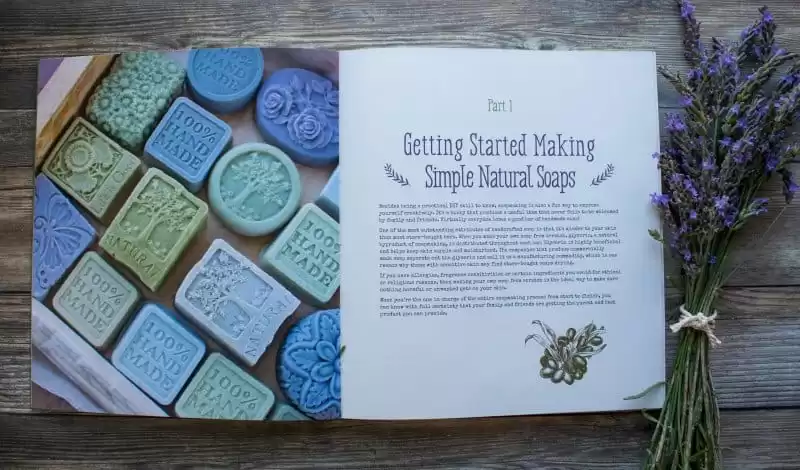
Calendula Tallow Soap Bars
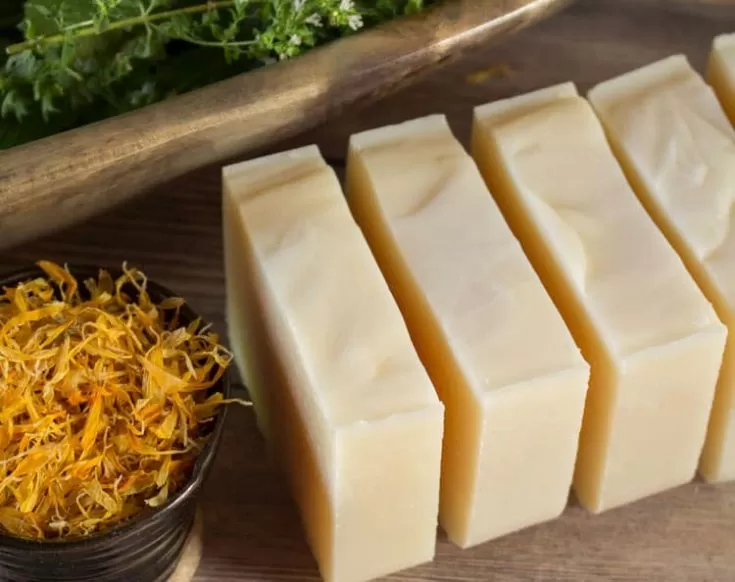
Make your own Calendula Tallow Soap Bars. This natural soap recipe features tallow and calendula flowers, for a hard, skin soothing soap bar.
Materials
- Lye Solution
- 8.75 oz (248 g) distilled water
- 3.9 oz (111 g) sodium hydroxide (lye)
- Solid Oils
- 5.5 oz (156 g) tallow (or lard)
- 7 oz (198 g) coconut oil
- Liquid Oils
- 12 oz (340 g) calendula infused olive oil
- 3.5 oz (99 g) sunflower or sweet almond oil
- Add at Trace
- 35 grams lavender essential oil (optional*)
Tools
- protective gloves and eyewear
- measuring cup
- immersion blender
- soap mold
- wax paper
Instructions
Step 1: Make the Lye Solution
Wearing protective gloves and eyewear, carefully stir the lye (sodium hydroxide) into the distilled until dissolved. Work in an area with good ventilation and be careful not to breathe in the fumes. Set the lye solution aside to cool for about 30 or 40 minutes or until the temperature drops to around 100 to 110°F (38 to 43°C).
Step 2: Prepare the Oils
Gently heat the coconut oil and tallow (or lard) on low heat until melted. When the solid oils are melted, take the pan off the heat and pour in the liquid oils. This helps cool down the melted oils, while warming up the room temperature oils.
Step 3: Mixing
Pour the cooled lye solution into the warmed oils. Using a combination of hand stirring and an immersion blender, also called a stick blender, stir the soap batter until it thickens and reaches a light trace. Trace is when the soap has thickened enough so when you drizzle a small amount of the batter across the surface, it will leave a fleeting, but visible imprint or “trace” before sinking back in.
Step 4: Add the Essential Oil
When the soap batter has thickened to the consistency of warm custard, stir in the essential oil(s) for scent.
Step 5: Pour in Mold
Pour the soap batter into your soap mold. Cover lightly with wax or freezer paper, then a towel or light blanket. Peek at the soap every so often; if it starts developing a crack, uncover and move to a cooler location.
Notes
Keep the soap in the mold for 1 to 2 days, or until it’s easy to remove, then slice it into bars when it’s firm enough not to stick to your cutting tool. Cure on coated cooling racks or sheets of wax paper for about 4 weeks before using. The soap is safe to touch 48 hours after making it but it needs the extra time to allow the excess moisture to evaporate out.
Notes & Substitution Ideas
- If you don’t have tallow or lard, you can replace it with 4 oz (113 g) cocoa butter plus 1.5 oz (43 g) castor oil. The lye amount will remain unchanged.
- To further enrich your soap, try adding 1 teaspoon of honey diluted with 1 teaspoon of water at trace (step 4), when you add the essential oil.
- For a different scent option, you could try the following citrus essential oil combination: 35 g orange essential oil (use a folded or Valencia type) and 8 g lemongrass or litsea essential oil
Pin it for Later:
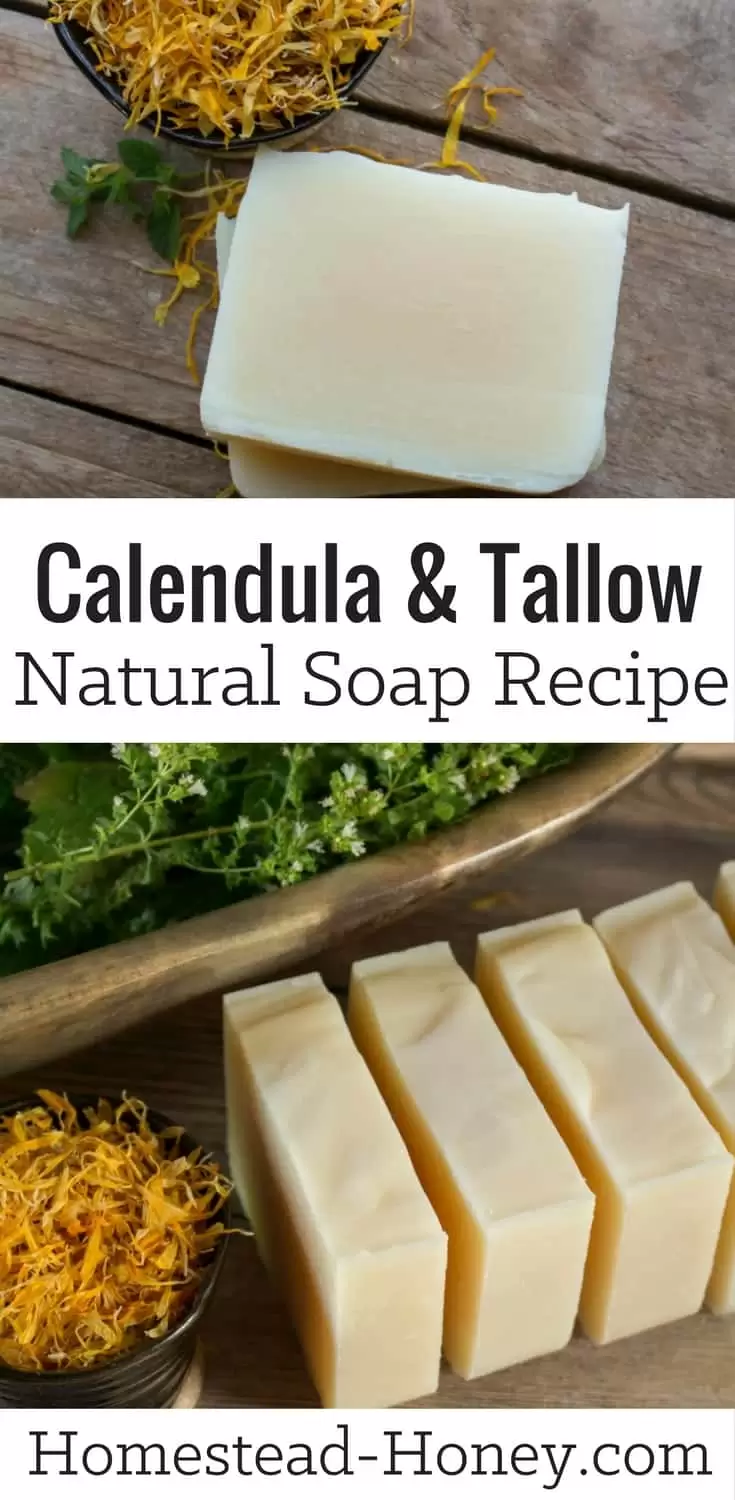

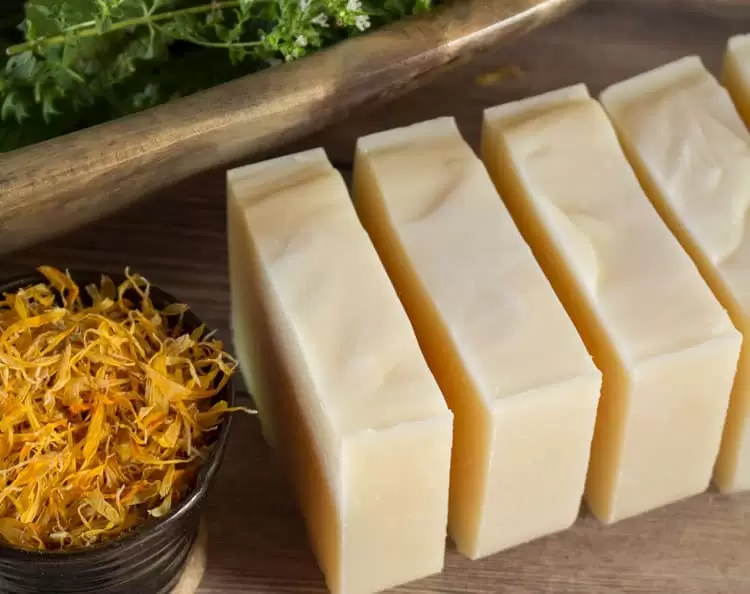
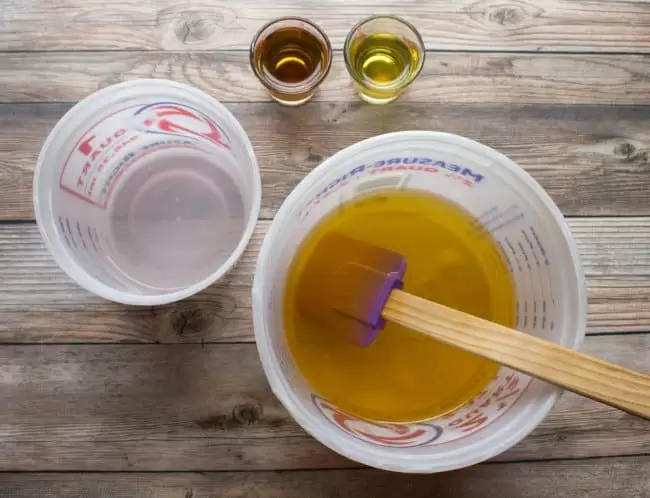

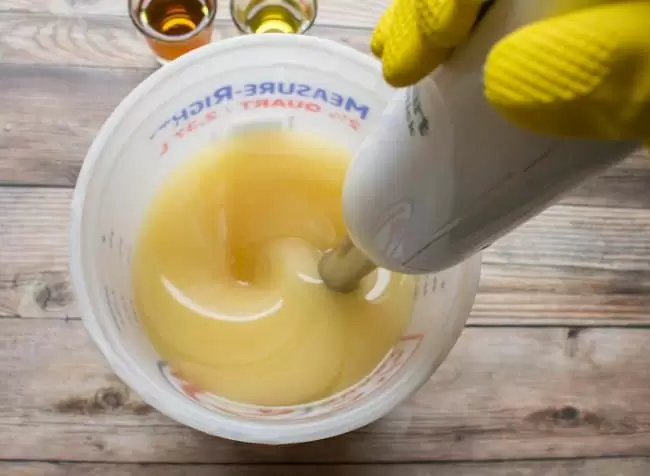
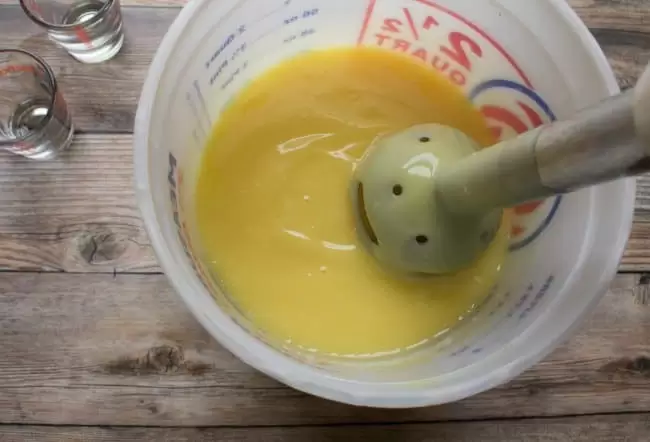
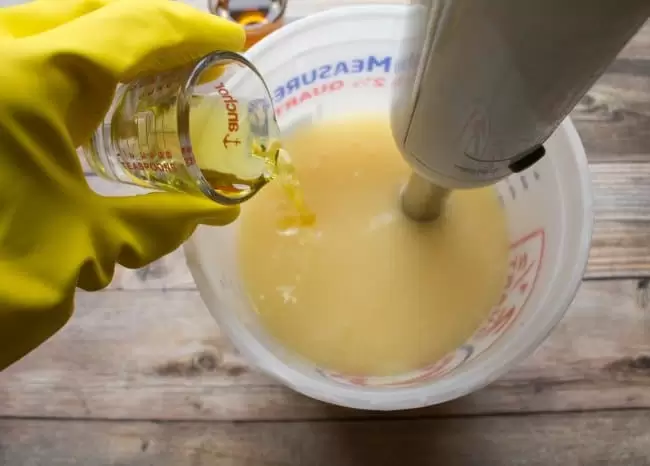


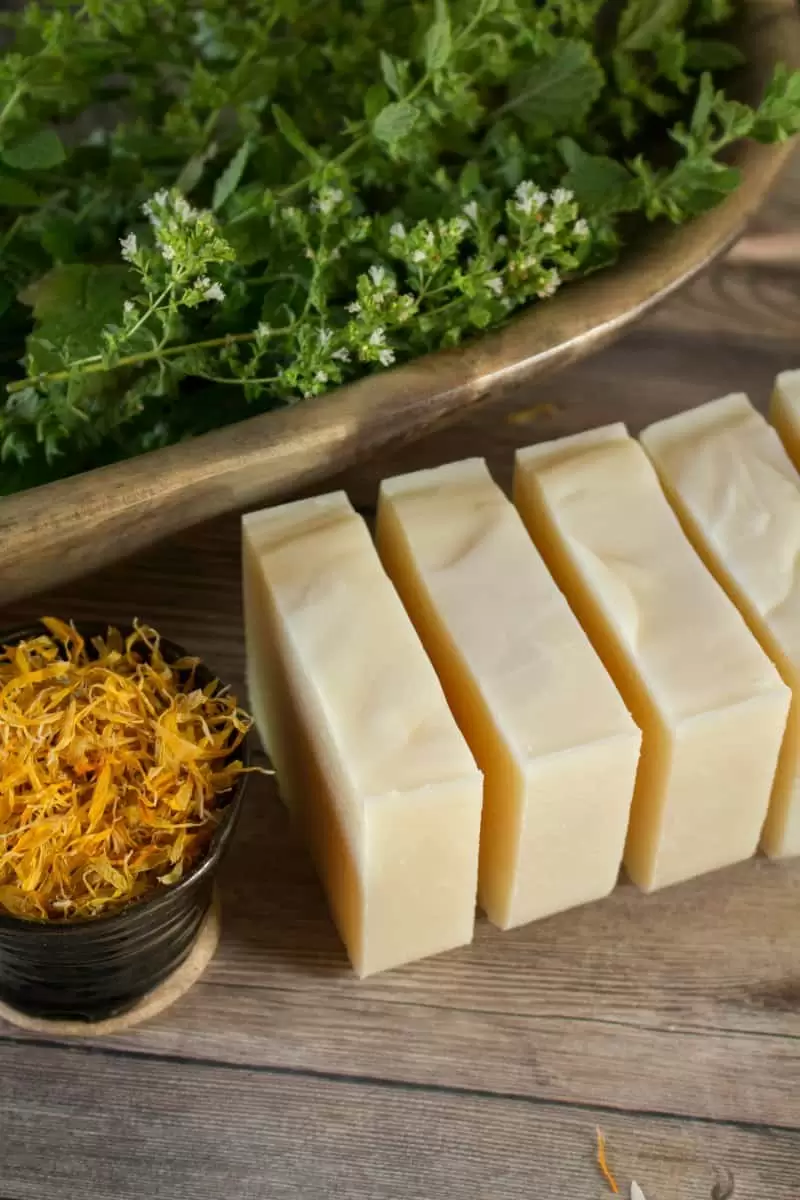





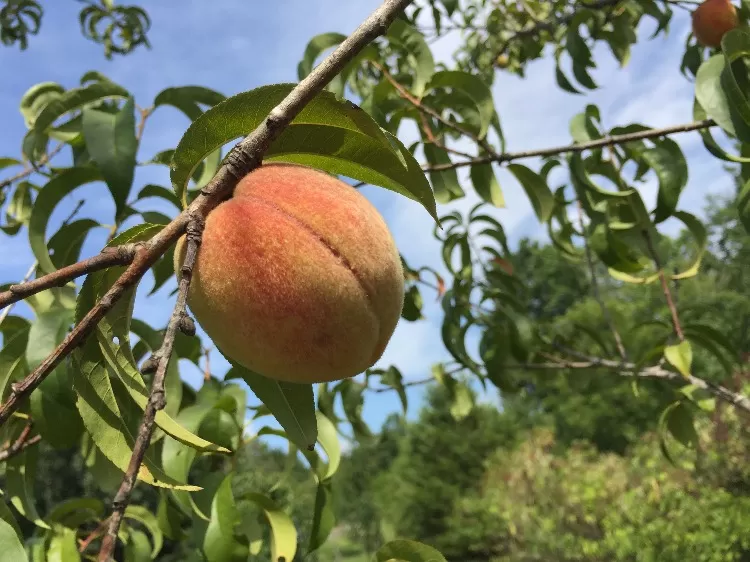


Really awesome job. Looks like a fun project.